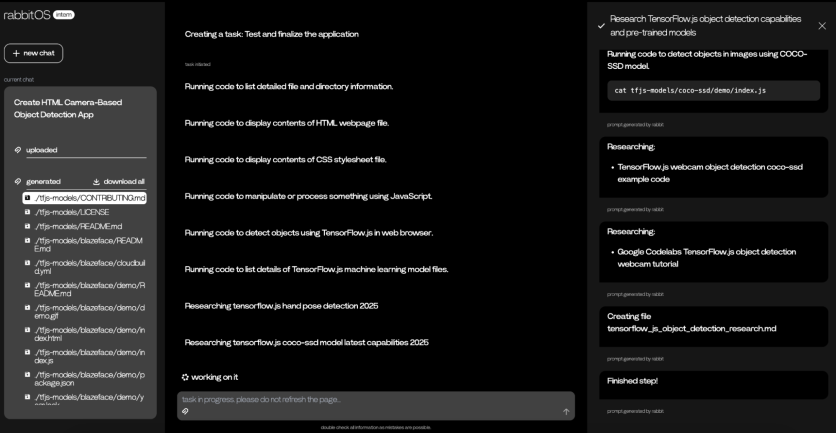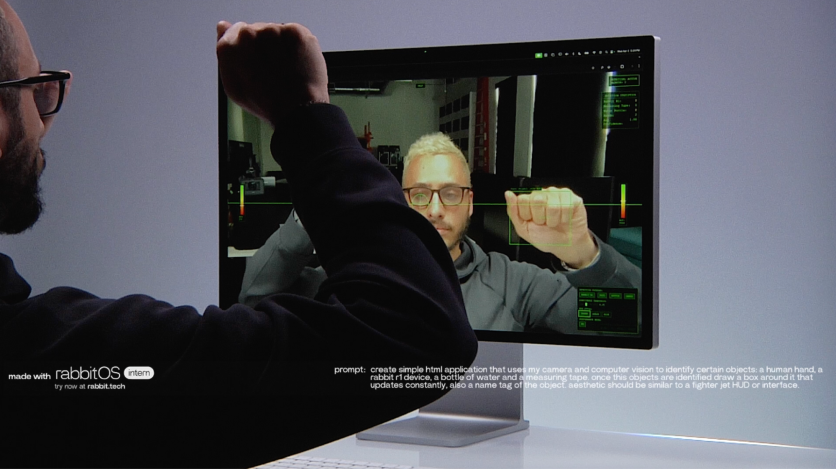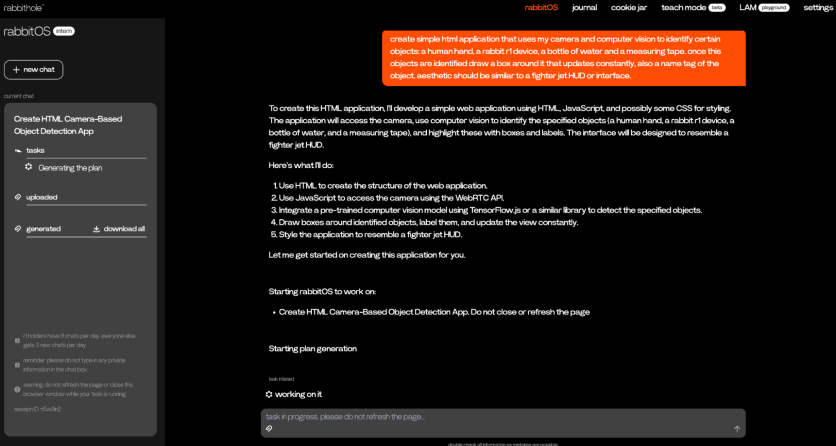In the rapidly evolving landscape of AI assistants and agents, rabbit has quickly emerged as a unique player with an ambitious vision to rethink how humans interact with machines. The latest offering from the company best known for "the little orange AI box that could," rabbit r1, is perhaps their most ambitious project yet. rabbit just launched an upgrade to their operating system, rabbitOS intern—the next step toward creating what they call a "general multi-agent operating system."
What does rabbit's intern do?
The rabbitOS intern interface follows rabbit's futuristic and minimalist design language. It has a sidebar on the left showing the name of the current task, a step-by-step breakdown of sub-tasks, uploaded files, and files that are generated as your intern is at work. The main working section in the middle gives you live updates on the task progress and also serves as the main chat window for you and the agent. If you click on any task from the left bar, a floating bar on the right slides out and shows details of each action the agent is doing to accomplish that single task. Also note that the number of remaining chats you have each day is displayed at the bottom left of the screen—r1 users get nine free ones per day during the free trial, while everyone else gets three.

The prompt I gave to the intern was to make a small-movement tracking web app that can identify specific objects like hands, glasses, and a rabbit r1. The intern didn't ask me additional questions but did confirm with me if I wanted to proceed. Then, it started to break down individual tasks step by step, analyze what needed to be done, and then execute it. The whole task took around 30 minutes, which rabbit told me was because of the complexity of this use case; simpler prompts can finish in 20 minutes or so.
When the task is completed, a list of files populated under the "generated" section, which you can download as a zip file or individually. After sifting through more than 10 files in the unzipped folder, I opened the index.html file to open the newly generated website. My browser asked me for permission to access my camera, and right then, when my face appeared on the screen, I was intrigued. Despite seeing hundreds of facial recognition demos in trade shows, building a functional tracker from scratch using nothing but my natural language prompt felt like a personal accomplishment. The motion tracker interface looked slightly different from what was in rabbit's demo video, but overall, it achieved exactly what the prompt asked for. For some reason, it was unable to detect my water bottle, but it knew that my left hand was holding it. But hey, if an intern delivered a project of this quality on the first try, I would be very pleased.


I'll probably keep playing with the intern, but overall, I'm happy with what it has delivered so far. When it comes to coding, the intern certainly knows more than I do. For things like research or conducting an audit, it's definitely faster than a human intern.
Building the Foundation and Features Together
What I believe sets rabbit apart is their approach to building the infrastructure and launching features as they go. rabbit said they have spent the past year constructing the underlying architecture for their agent system. At the same time, they've pushed out more than 30 over-the-air updates for the rabbit r1 device. This two-pronged approach seems to be working well since rabbitOS intern appears to handle complex agent flows more thoughtfully compared to some alternatives.
The coordination and planning capabilities among multiple "intern" agents within their system are designed to deliver comprehensively researched results. While it's true that rabbit has moved very quickly and got off to a rocky start, they have done a remarkable job building robust backend systems over a very short period of time—a strategy that could pay dividends as they scale their capabilities and build out their multi-agent system.
Cross-Platform Ambitions
Perhaps the most intriguing aspect of rabbit's strategy is their vision for cross-platform functionality. While many competitors have focused on specific domains, rabbit has steadily expanded their reach across different environments.
The company has been very active in building a variety of AI agents, including LAM playground, a general web agent that launched in October, and an Android agent that they previewed in February. They are reportedly merging these agentic capabilities into one cohesive system.
The Integration Challenge
Integrating platform-specific agents into rabbitOS intern represents both an opportunity and a challenge. If executed successfully, this integration could create a seamless experience where users don't need to switch between different assistants for different tasks—a significant usability improvement over the current fragmented landscape of AI tools.
However, the technical challenges in achieving this kind of integration shouldn't be underestimated. Creating agents that can effectively operate across platforms, maintain context, and deliver consistent responses represents a substantial engineering challenge.
Evaluating Progress Through Iteration
What's encouraging about rabbit's development approach is their commitment to continuous improvement. The team has demonstrated a pattern of consistent shipping and iteration on their products. The rabbitOS intern itself shows promising capabilities already, and it's only been available for the general public to try for less than a week. (By comparison, the Chinese platform Manus is still in closed beta at the time of this article's publication and has fallen short of many of its promises.)
rabbit has also told me that they will use their free trial period to gather user feedback and make adjustments to their "intern." If done well, this could help shape the future development of rabbitOS based on real-world usage rather than theoretical assumptions about what users might want.
Based on the speed at which rabbit has built, iterated, and improved its offerings so far, any lingering criticism they may still face from their early stumbles seems, to me, rather unjustified.
Looking Forward: Potential and Challenges
As rabbit continues developing rabbitOS into a more robust multi-agent operating system, several questions remain. Can they successfully integrate their various platform-specific agents into a truly cohesive system? Will they be able to maintain quality and reliability as they expand their capabilities? And perhaps most importantly, how will they continue to leverage their hardware offerings as agentic software iterates at such a frenetic pace?
The concept of a general agent operating system remains compelling because, in theory, it simplifies human interaction with increasingly complex digital environments. Only time will tell whether rabbit's approach—or those of Apple, Google, Meta, Amazon, OpenAI, or any startup, even—will fulfill that vision.
For now, rabbitOS intern appears to be a commendable step forward. As the AI race continues to heat up, rabbit's progress will be worth watching closely.




